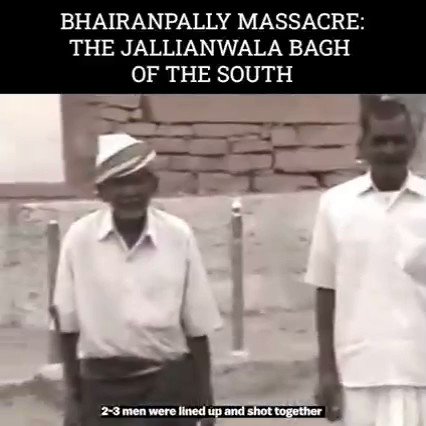When Nizam’s Police shot 200 hindus for refusing to pay Jizya in Independent India


We all have heard about the Jallianwallah Bagh massacre of 1919 that led to the gruesome murder of 379 innocent Indians. But have you heard about a similar incident that happened post-independence? Nizam’s police shot 200 Hindus dead in 1948 after forcing them to stand in line. The sole reason for the act was refusing to pay the Jizya tax. It took place in Bhairanpally. The Bhairanpally Massacre is not taught in schools, although Jallianwala Bagh is.
Nizam has been receiving a lot of accolades from Telangana CM in speeches. Such exaltation of Nizam hides the fact that his dominion was the most ominous period in Deccan history. A genocide against his Hindu subjects is a terrible chapter in Nizam’s history. Before Sardar Patel seized Hyderabad in 1948, historians estimate that 100,000 Hindus were slaughtered by the Nizam’s police and Razakars.
Nizam was a Jihadi who openly declared his desire to eradicate Hindus. “Mai Pasban-e-din hoon Kuffar ka jallad hoon,” he says in his own poem, “means “I am the guardian of Islam and a butcher/executioner of Kaffirs (Non-Muslims)”.
Around 360 ladies served as concubines for Nizam. These women were mostly kidnapped by non-Muslim Kafirs during raids. His network of slaves was so extensive that he even bought non-Muslim girls between the ages of 10 and 12 from Nuristan (Afghanistan) as sex slaves.
Muslims made up 13% of the population in Nizam’s Hyderabad. But they had access to 77% of government jobs that were listed. Both 82% of lower-level and 88% of higher level government officials identified as Muslim. Almost no Hindus were present. However, Hindus contributed 97% of the state’s income. Hindus paid too much tax.
Hitler was admired by Nizam. He felt that Hindus should be handled in Nazi Germany much like Jews. There was a difficulty. In contrast to Jews in Germany, Hindus were not a minority. Nizam aimed to lower the number of Hindus by persecuting them, bringing in foreign Muslims, and promoting conversions.
Nizam brought in 8 lakh immigrant Muslims in order to lessen the Hindu majority. Arabs and Afghans are two of these. They received all state advantages. These foreign imports received the same rights to possess guns as other Muslims. Hindus were, however, demilitarised and prohibited from owning weapons.
These non-Arab foreign Muslims made up a sizable portion of Nizam’s army. Even Sayyid El Edross, his commander in chief, was an Arab. Most of these Arabs remained at the rear. Many thousands of Yemeni Arabs can be found in Barkas (Hyderabad) today.
Nizam also started massive conversion campaigns. A guy by the name of Siddique, who started the Dindar movement, was in his service. The Dindars were a group of bandits that specialised in conversions and looting. Siddique, who received funding from Nizam, referred to himself as an avatar of Basaveshwara.
According to Siddique, the Vedas and the Qur’an both laud Nizam. He even claimed that Dharmaraja, not Nizam, was Nizam. He also asserted that Nizam would eventually conquer Delhi and hoist the Islamic flag atop Red Fort. With the aid of Nizam, Siddique converted thousands of Hindus.
All Hindus would convert to Islam, according to Siddique, and all Hindu idols would be demolished. Gandhi and Nehru would convert, he predicted. He warned of impending genocide and urged Hindus to convert in order to avoid it. Conversions took place in government buildings.
Nizam also announced an offer for offenders to convert in exchange for their freedom from prison! In order to avoid an approaching jail sentence, hundreds of criminals and inmates converted in this way. After being released from prison, they immediately enlisted in the Razakars.
In Nizam’s empire, the reduction of the Hindu population was so observed. Hindus made up 90.53% of the population in 1891. They were 86.15% when Osman Ali Khan came to power in 1911. They fell to little about 80% by the conclusion of his rule.
Hindus were not allowed to construct temples in “Muslim territories” throughout Nizam’s empire. Hindu temples were frequently vandalized, yet no one was ever held accountable. While Muslims openly offered public prayers and converted, Hindus were forbidden from doing public poojas and kathas.
DISCLAIMER: The author is solely responsible for the views expressed in this article. The author carries the responsibility for citing and/or licensing of images utilized within the text.
